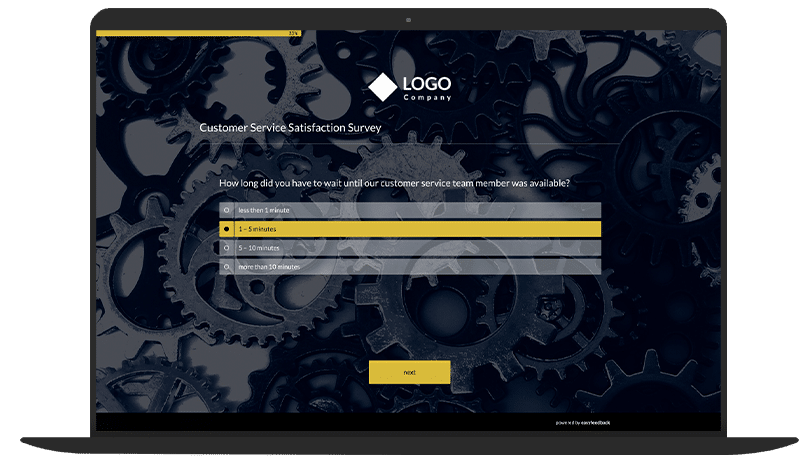What is customer loyalty in marketing?
Customer retention in marketing refers to a company’s efforts to retain existing customers over the long term by increasing their satisfaction, building trust and maintaining a positive relationship.
Strong customer loyalty is critical to a company’s long-term success, as repeat customers often generate recurring revenue and can potentially attract new customers through positive word of mouth.
Strategy 1: Improve customer experience
An outstanding customer experience is at the heart of any successful customer retention strategy.
It is the quintessence that not only satisfies customers, but also binds them to a company in the long term.

This experience spans various touchpoints along the entire customer journey and encompasses a variety of aspects that together create an unforgettable experience.
First and foremost, ease of purchase and payment options are crucial. Customers appreciate seamless and user-friendly processes that allow them to purchase products or services with ease, whether online or offline.
An intuitive website, clear instructions and various payment options help to break down barriers and make it easier to complete a purchase.
Fast delivery is another key aspect.
In a world characterized by instant gratification, customers expect their orders to be delivered promptly and reliably.
Companies that manage to ensure efficient delivery processes can gain a competitive advantage and strengthen the trust of their customers.
Excellent customer service plays another indispensable role in the pursuit of customer satisfaction and loyalty.
Customers want to feel valued and listened to. Friendly, knowledgeable and responsive support for questions, problems or complaints plays a key role in building and strengthening positive customer relationships.

Personalized interactions are also very important. Customers want to feel individually addressed and recognized.
By using customer information and data, companies can create personalized offers, recommendations and communications that meet the specific needs and preferences of each customer.
In summary, an outstanding customer experience is a complex interplay of different factors, all aimed at meeting the needs, expectations and desires of customers.
Companies that invest in providing such experiences can not only increase customer satisfaction and loyalty, but also achieve long-term success and sustainable growth.
Strategy 2: Customer loyalty through rewards
Reward programs and loyalty rewards are like a sparkling lure for customers, encouraging them to return to a company again and again.
They form the link between the company and the customer and create an emotional bond that goes far beyond the pure transaction value.
These programs offer a variety of incentives that encourage customers to express their loyalty and do business regularly.
These incentives can be presented in a variety of forms to suit customers’ needs and preferences.

For example, discounts can provide a direct financial incentive that encourages customers to buy more, while vouchers offer additional flexibility by allowing customers to make their purchases at a later date or experience specific products or services.
Exclusive offers are like a secret jewel reserved for only the most loyal customers. They make the customer feel valued and privileged, which in turn strengthens loyalty and makes them want to continue interacting with the company.
Points systems are another popular form of rewards program that encourage customers to regularly do business to earn points that they can later redeem for rewards or perks.
These systems not only provide an incentive to purchase, but also allow companies to track customers’ purchasing behavior and create tailored offers that meet their needs.
Overall, rewards programs and loyalty rewards are a powerful way to promote customer loyalty and increase customer engagement.
They create a win-win situation by rewarding customers while promoting business growth and long-term company profitability.
Strategy 3: Communication and engagement
The art of communicating regularly with customers is like weaving a fine but strong thread that connects companies and customers.
This ongoing interaction, whether via email, social media or other communication channels, creates a connection that goes far beyond simple transactions.

This relationship building is invaluable in fostering customer loyalty and building long-term loyalty.
By regularly sharing news and information, companies can create an atmosphere of trust and connection.
Customers feel heard and valued when they are regularly informed about news, offers and relevant information.
This constant dialog also allows companies to establish themselves as a reliable source for their customers and offer added value beyond the actual product or service.
The choice of communication channels plays a crucial role in effective customer retention.
Email offers a direct and personal way to reach customers, while social media provides a platform to build a community and encourage customer interaction.
Other channels such as SMS, chatbots or even traditional mail can also be used to expand the variety of communication options and appeal to different customer segments.
It is important that this communication is not one-sided, but also offers room for feedback and interaction.
Customers should be encouraged to ask questions, give feedback and actively participate in discussions. This promotes a sense of belonging and gives customers the feeling that their opinions and needs are being heard.
Strategy 4: Personalization
The art of personalization through the use of data and customer information is like tailoring a bespoke suit for each individual customer.
By gaining insights into their customers’ behavior, preferences and history, companies can create tailored offers and recommendations that are precisely tailored to their individual needs and preferences.
These personalized interactions go beyond the mere transaction and create a deeper bond between company and customer.

By analyzing data such as past purchases, search queries, demographic information and even social media, companies can paint a comprehensive picture of their customers.
These insights make it possible to recognize patterns and make accurate predictions about what customers may be interested in or need.
Based on these insights, companies can then create personalized offers that are tailored to the individual needs and preferences of each customer.
Whether it’s tailored product suggestions, individual discounts or special promotions, personalized offers show customers that they are noticed and appreciated.
In addition, personalized recommendations can further strengthen customer loyalty by improving the shopping experience and helping customers discover relevant products or services that they might otherwise have overlooked.
This not only leads to higher sales, but also to an increased sense of satisfaction and loyalty on the part of the customer.
Strategy 5: Use customer feedback
Gathering feedback from customers is like opening a treasure chest full of valuable insights and knowledge for companies.
By actively listening to the voices of their customers and taking their opinions and suggestions into account, companies create a valuable feedback loop that enables them to continuously improve products and services and increase customer satisfaction.
Customer feedback is an invaluable source of constructive criticism and valuable suggestions. By being open to feedback, companies can gain valuable insight into how their products or services are perceived.

This enables them to recognize strengths and identify weaknesses that need to be improved.
Taking customer opinions and suggestions into account is a crucial step in optimizing the quality of products and services.
Customers are often the best experts on their own needs and can provide valuable ideas on how products or services can be improved to better meet their requirements.
In addition, gathering feedback helps to build a close relationship between the company and its customers.
Customers feel heard and valued when they see that their opinions are taken seriously and actually have an impact on business practices. This strengthens customer trust and loyalty and promotes long-term retention.
Ultimately, continuous improvement based on customer feedback is an essential part of any successful customer retention strategy.
By proactively addressing the needs and wants of their customers, companies can provide an outstanding customer experience and build long-term relationships characterized by trust and satisfaction.
Strategy 6: Crisis management
The art of handling complaints and problems professionally and efficiently is like weaving a strong safety net for customer loyalty.
In moments of dissatisfaction or frustration, companies can take the opportunity to build customer trust and foster a long-term relationship by responding in a way that goes beyond simply solving the problem.

The way a company handles complaints can have a significant impact on customer perception and loyalty.
A professional and empathetic approach shows customers that their concerns are taken seriously and that the company is interested in finding a satisfactory solution.
Efficiency also plays a decisive role. Customers appreciate it when their problems are solved quickly and competently.
Prompt action on the part of the company signals that customer satisfaction is a top priority and that the company is prepared to go the extra mile to meet its customers’ needs.
In addition, dealing with complaints and problems in a professional manner provides an opportunity to rebuild trust.
By communicating transparently, taking responsibility and offering appropriate compensation, companies can restore customer trust and promote a positive perception of the company.
Last but not least, dealing with complaints and issues is an opportunity for companies to learn valuable lessons and improve their processes.
By using feedback from customers to identify weaknesses and find solutions, companies can strengthen their service quality and customer loyalty in the long term.
Conclusion: Start with one strategy!
As mentioned at the beginning of the article, successful customer retention in marketing is a crucial factor in the long-term success of any business.
By implementing the six strategies presented – from creating outstanding customer experiences to using rewards programs to communicating effectively and handling customer feedback – companies can build and maintain a strong bond with their customers.
Effective customer loyalty goes far beyond simply making a purchase.
It creates loyal ambassadors for the brand who not only buy regularly but also share their positive experiences with others.
These loyal customers form the backbone of a company’s sustainable growth and long-term success.
By taking their customers’ needs, preferences and feedback seriously and responding to them, companies can build a personal relationship that goes beyond transactions and creates a lasting bond.
At a time when competition is increasing and consumer expectations are rising, strong customer loyalty is more crucial than ever to a company’s success.
By applying these six strategies, companies can not only strengthen the loyalty of their customers, but also grow their business sustainably and gain a competitive advantage.
Investing in customer loyalty pays off in the long term and helps to build a strong and successful brand.





